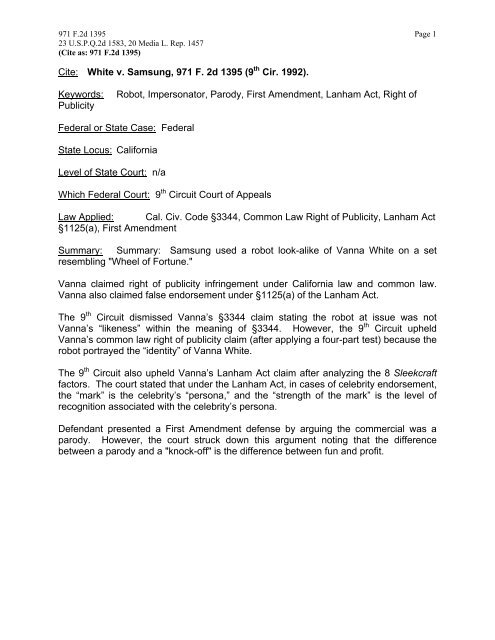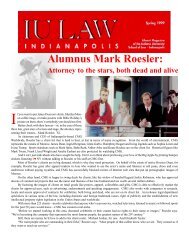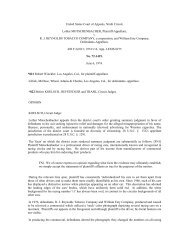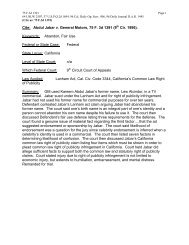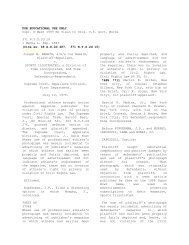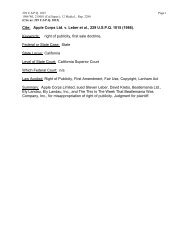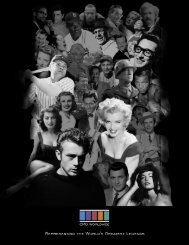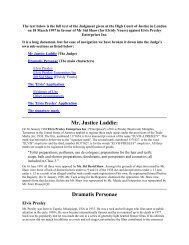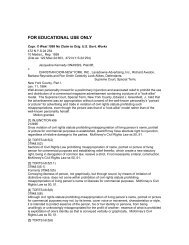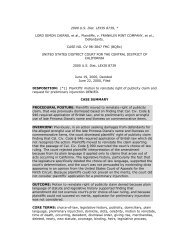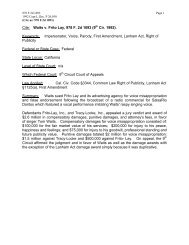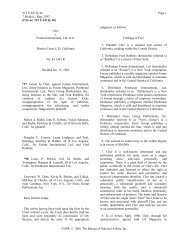White v. Samsung, 971 F. 2d 1395 (9th Cir. 1992). - Mark Roesler
White v. Samsung, 971 F. 2d 1395 (9th Cir. 1992). - Mark Roesler
White v. Samsung, 971 F. 2d 1395 (9th Cir. 1992). - Mark Roesler
Create successful ePaper yourself
Turn your PDF publications into a flip-book with our unique Google optimized e-Paper software.
<strong>971</strong> F.<strong>2d</strong> <strong>1395</strong> Page 123 U.S.P.Q.<strong>2d</strong> 1583, 20 Media L. Rep. 1457(Cite as: <strong>971</strong> F.<strong>2d</strong> <strong>1395</strong>)Cite: <strong>White</strong> v. <strong>Samsung</strong>, <strong>971</strong> F. <strong>2d</strong> <strong>1395</strong> (9 th <strong>Cir</strong>. <strong>1992</strong>).Keywords:PublicityRobot, Impersonator, Parody, First Amendment, Lanham Act, Right ofFederal or State Case: FederalState Locus: CaliforniaLevel of State Court: n/aWhich Federal Court: 9 th <strong>Cir</strong>cuit Court of AppealsLaw Applied: Cal. Civ. Code §3344, Common Law Right of Publicity, Lanham Act§1125(a), First AmendmentSummary: Summary: <strong>Samsung</strong> used a robot look-alike of Vanna <strong>White</strong> on a setresembling "Wheel of Fortune."Vanna claimed right of publicity infringement under California law and common law.Vanna also claimed false endorsement under §1125(a) of the Lanham Act.The 9 th <strong>Cir</strong>cuit dismissed Vanna’s §3344 claim stating the robot at issue was notVanna’s “likeness” within the meaning of §3344. However, the 9 th <strong>Cir</strong>cuit upheldVanna’s common law right of publicity claim (after applying a four-part test) because therobot portrayed the “identity” of Vanna <strong>White</strong>.The 9 th <strong>Cir</strong>cuit also upheld Vanna’s Lanham Act claim after analyzing the 8 Sleekcraftfactors. The court stated that under the Lanham Act, in cases of celebrity endorsement,the “mark” is the celebrity’s “persona,” and the “strength of the mark” is the level ofrecognition associated with the celebrity’s persona.Defendant presented a First Amendment defense by arguing the commercial was aparody. However, the court struck down this argument noting that the differencebetween a parody and a "knock-off" is the difference between fun and profit.
<strong>971</strong> F.<strong>2d</strong> <strong>1395</strong> Page 323 U.S.P.Q.<strong>2d</strong> 1583, 20 Media L. Rep. 1457(Cite as: <strong>971</strong> F.<strong>2d</strong> <strong>1395</strong>)Midler v. Ford Motor Co., 849 F.<strong>2d</strong> 460 (<strong>9th</strong><strong>Cir</strong>.1988), this court rejected Bette Midler's section3344 claim concerning a Ford television commercialin which a Midler "sound-alike" sang a song whichMidler had made famous. In rejecting Midler'sclaim, this court noted that "[t]he defendants did notuse Midler's name or anything else whose use isprohibited by the statute. The voice they used was[another person's], not hers. The term 'likeness'refers to a visual image not a vocal imitation." Id. at463.In this case, <strong>Samsung</strong> and Deutsch used a robot withmechanical features, and not, for example, a manikinmolded to <strong>White</strong>'s precise features. Withoutdeciding for all purposes when a caricature orimpressionistic resemblance might become a"likeness," we agree with the district court that therobot at issue here was not <strong>White</strong>'s "likeness" withinthe meaning of section 3344. Accordingly, we affirmthe court's dismissal of <strong>White</strong>'s section 3344 claim.II. Right of Publicity[2] <strong>White</strong> next argues that the district court erred ingranting summary judgment to defendants on <strong>White</strong>'scommon law right of publicity claim. In Eastwoodv. Superior Court, 149 Cal.App.3d 409, 198 Cal.Rptr.342 (1983), the California court of appeal stated thatthe common law right of publicity cause of action"may be pleaded by alleging (1) the defendant's useof the plaintiff's identity; (2) the appropriation ofplaintiff's name or likeness to defendant's advantage,commercially or otherwise; (3) lack of consent; and(4) resulting injury." Id. at 417, 198 Cal.Rptr. 342(citing Prosser, Law of Torts (4th ed. 1<strong>971</strong>) § 117,pp. 804-807). The district court dismissed <strong>White</strong>'sclaim for failure to satisfy Eastwood's second prong,reasoning that defendants had not appropriated<strong>White</strong>'s "name or likeness" with their robot ad. Weagree that the robot ad did not make use of <strong>White</strong>'sname or likeness. However, the common law right ofpublicity is not so confined.The Eastwood court did not hold that the right ofpublicity cause of action could be pleaded only byalleging an appropriation of name or likeness.Eastwood involved an unauthorized use ofphotographs of Clint Eastwood and of his name.Accordingly, the Eastwood court had no occasion toconsider the extent beyond the use of name orlikeness to which the right of publicity reaches. Thatcourt held only that the right of publicity cause ofaction "may be" pleaded by alleging, inter alia,appropriation of name or likeness, not that the actionmay be pleaded only in those terms.The "name or likeness" formulation referred to inEastwood originated not as an element of the right ofpublicity cause of action, but as a description of thetypes of cases in which the cause of action had beenrecognized. The source of this formulation isProsser, Privacy, 48 Cal.L.Rev. 383, 401-07 (1960),one of the earliest and most enduring articulations ofthe common law right of publicity cause of action.In looking at the case law to that point, Prosserrecognized that right of publicity cases involved oneof two basic factual scenarios: name appropriation,and picture or other likeness appropriation. Id. at401-02, nn. 156-57.Even though Prosser focused on appropriations ofname or likeness in discussing the right of publicity,he noted that "[i]t is not impossible that there mightbe appropriation of the plaintiff's identity, as byimpersonation, without the use of either his name orhis likeness, and that this would *1398 be an invasionof his right of privacy." Id. at 401, n. 155. [FN1] Atthe time Prosser wrote, he noted however, that "[n]osuch case appears to have arisen." Id.FN1. Under Professor Prosser's scheme, theright of publicity is the last of the fourcategories of the right to privacy. Prosser,48 Cal.L.Rev. at 389.Since Prosser's early formulation, the case law hasborne out his insight that the right of publicity is notlimited to the appropriation of name or likeness. InMotschenbacher v. R.J. Reynolds Tobacco Co., 498F.<strong>2d</strong> 821 (<strong>9th</strong> <strong>Cir</strong>.1974), the defendant had used aphotograph of the plaintiff's race car in a televisioncommercial. Although the plaintiff appeared drivingthe car in the photograph, his features were notvisible. Even though the defendant had notappropriated the plaintiff's name or likeness, thiscourt held that plaintiff's California right of publicityclaim should reach the jury.In Midler, this court held that, even though thedefendants had not used Midler's name or likeness,Midler had stated a claim for violation of herCalifornia common law right of publicity because"the defendants ... for their own profit in selling theirproduct did appropriate part of her identity" by usinga Midler sound-alike. Id. at 463-64.In Carson v. Here's Johnny Portable Toilets, Inc.,
<strong>971</strong> F.<strong>2d</strong> <strong>1395</strong> Page 423 U.S.P.Q.<strong>2d</strong> 1583, 20 Media L. Rep. 1457(Cite as: <strong>971</strong> F.<strong>2d</strong> <strong>1395</strong>)698 F.<strong>2d</strong> 831 (6th <strong>Cir</strong>.1983), the defendant hadmarketed portable toilets under the brand name"Here's Johnny"--Johnny Carson's signature "TonightShow" introduction--without Carson's permission.The district court had dismissed Carson's Michigancommon law right of publicity claim because thedefendants had not used Carson's "name or likeness."Id. at 835. In reversing the district court, the sixthcircuit found "the district court's conception of theright of publicity ... too narrow" and held that theright was implicated because the defendant hadappropriated Carson's identity by using, inter alia, thephrase "Here's Johnny." Id. at 835-37.[3] These cases teach not only that the common lawright of publicity reaches means of appropriationother than name or likeness, but that the specificmeans of appropriation are relevant only fordetermining whether the defendant has in factappropriated the plaintiff's identity. The right ofpublicity does not require that appropriations ofidentity be accomplished through particular means tobe actionable. It is noteworthy that the Midler andCarson defendants not only avoided using theplaintiff's name or likeness, but they also avoidedappropriating the celebrity's voice, signature, andphotograph. The photograph in Motschenbacher didinclude the plaintiff, but because the plaintiff was notvisible the driver could have been an actor or dummyand the analysis in the case would have been thesame.Although the defendants in these cases avoided themost obvious means of appropriating the plaintiffs'identities, each of their actions directly implicated thecommercial interests which the right of publicity isdesigned to protect. As the Carson court explained:[t]he right of publicity has developed to protect thecommercial interest of celebrities in their identities.The theory of the right is that a celebrity's identitycan be valuable in the promotion of products, andthe celebrity has an interest that may be protectedfrom the unauthorized commercial exploitation ofthat identity.... If the celebrity's identity iscommercially exploited, there has been an invasionof his right whether or not his "name or likeness" isused.Carson, 698 F.<strong>2d</strong> at 835. It is not important howthe defendant has appropriated the plaintiff'sidentity, but whether the defendant has done so.Motschenbacher, Midler, and Carson teach theimpossibility of treating the right of publicity asguarding only against a laundry list of specificmeans of appropriating identity. A rule whichsays that the right of publicity can be infringedonly through the use of nine different methods ofappropriating identity merely challenges the cleveradvertising strategist to come up with the tenth.*1399 Indeed, if we treated the means ofappropriation as dispositive in our analysis of theright of publicity, we would not only weaken theright but effectively eviscerate it. The right wouldfail to protect those plaintiffs most in need of itsprotection. Advertisers use celebrities to promotetheir products. The more popular the celebrity, thegreater the number of people who recognize her,and the greater the visibility for the product. Theidentities of the most popular celebrities are notonly the most attractive for advertisers, but also theeasiest to evoke without resorting to obvious meanssuch as name, likeness, or voice.Consider a hypothetical advertisement whichdepicts a mechanical robot with male features, anAfrican-American complexion, and a bald head.The robot is wearing black hightop Air Jordanbasketball sneakers, and a red basketball uniformwith black trim, baggy shorts, and the number 23(though not revealing "Bulls" or "Jordan"lettering). The ad depicts the robot dunking abasketball one-handed, stiff-armed, legs extendedlike open scissors, and tongue hanging out. Nowenvision that this ad is run on television duringprofessional basketball games. Consideredindividually, the robot's physical attributes, itsdress, and its stance tell us little. Taken together,they lead to the only conclusion that any sportsviewer who has registered a discernible pulse in thepast five years would reach: the ad is aboutMichael Jordan.Viewed separately, the individual aspects of theadvertisement in the present case say little.Viewed together, they leave little doubt about thecelebrity the ad is meant to depict. The femaleshapedrobot is wearing a long gown, blond wig,and large jewelry. Vanna <strong>White</strong> dresses exactlylike this at times, but so do many other women.The robot is in the process of turning a block letteron a game-board. Vanna <strong>White</strong> dresses like thiswhile turning letters on a game-board but perhapssimilarly attired Scrabble-playing women do this aswell. The robot is standing on what looks to bethe Wheel of Fortune game show set. Vanna<strong>White</strong> dresses like this, turns letters, and does thison the Wheel of Fortune game show. She is theonly one. Indeed, defendants themselves referredto their ad as the "Vanna <strong>White</strong>" ad. We are not
<strong>971</strong> F.<strong>2d</strong> <strong>1395</strong> Page 523 U.S.P.Q.<strong>2d</strong> 1583, 20 Media L. Rep. 1457(Cite as: <strong>971</strong> F.<strong>2d</strong> <strong>1395</strong>)surprised.Television and other media create marketablecelebrity identity value. Considerable energy andingenuity are expended by those who haveachieved celebrity value to exploit it for profit.The law protects the celebrity's sole right to exploitthis value whether the celebrity has achieved herfame out of rare ability, dumb luck, or acombination thereof. We decline <strong>Samsung</strong> andDeutch's invitation to permit the evisceration of thecommon law right of publicity through means asfacile as those in this case. Because <strong>White</strong> hasalleged facts showing that <strong>Samsung</strong> and Deutschhad appropriated her identity, the district courterred by rejecting, on summary judgment, <strong>White</strong>'scommon law right of publicity claim.III. The Lanham Act[4] <strong>White</strong>'s final argument is that the district courterred in denying her claim under § 43(a) of theLanham Act, 15 U.S.C. § 1125(a). The version ofsection 43(a) applicable to this case [FN2]provides, in pertinent part, that "[a]ny person whoshall ... use, in connection with any goods orservices ... any false description or representation... shall be liable to a civil action ... by any personwho believes that he is or is likely to be damagedby the use of any such false description ordesignation." 15 U.S.C. § 1125(a).FN2. The statute was amended after <strong>White</strong>filed her complaint. The amendmentswould not have altered the analysis in thiscase however.To prevail on her Lanham Act claim, <strong>White</strong> isrequired to show that in running the robot ad,<strong>Samsung</strong> and Deutsch created a likelihood ofconfusion, Academy of Motion Picture Arts v.Creative House, 944 F.<strong>2d</strong> 1446, 1454 (<strong>9th</strong> <strong>Cir</strong>.1991);Toho Co. Ltd. v. Sears Roebuck & Co., 645 F.<strong>2d</strong> 788,790 (<strong>9th</strong> <strong>Cir</strong>.1981) *1400New West Corp. v. NYMCo. of California, 595 F.<strong>2d</strong> 1194, 1201 (<strong>9th</strong><strong>Cir</strong>.1979), over whether <strong>White</strong> was endorsing<strong>Samsung</strong>'s VCRs. HMH Publishing Co. v. Brincat,504 F.<strong>2d</strong> 713 (<strong>9th</strong> <strong>Cir</strong>.1974); Allen v. NationalVideo, Inc., 610 F.Supp. 612 (D.C.N.Y.1985).[5] This circuit recognizes several different multifactortests for determining whether a likelihood ofconfusion exists. See Academy, 944 F.<strong>2d</strong> at 1454, n.3. None of these tests is correct to the exclusion ofthe others. Eclipse Associates Ltd. v. Data GeneralCorp., 894 F.<strong>2d</strong> 1114, 1118 (<strong>9th</strong> <strong>Cir</strong>.1990).Normally, in reviewing the district court's decision,this court will look to the particular test that thedistrict court used. Academy, 944 F.<strong>2d</strong> at 1454, n. 3;Eclipse, 894 F.<strong>2d</strong> at 1117-1118. However, becausethe district court in this case apparently did not useany of the multi-factor tests in making its likelihoodof confusion determination, and because this caseinvolves an appeal from summary judgment and wereview de novo the district court's determination, wewill look for guidance to the 8- factor test enunciatedin AMF, Inc. v. Sleekcraft Boats, 599 F.<strong>2d</strong> 341 (<strong>9th</strong><strong>Cir</strong>.1979). According to AMF, factors relevant to alikelihood of confusion include:(1) strength of the plaintiff's mark;(2) relatedness of the goods;(3) similarity of the marks;(4) evidence of actual confusion;(5) marketing channels used;(6) likely degree of purchaser care;(7) defendant's intent in selecting the mark;(8) likelihood of expansion of the product lines.599 F.<strong>2d</strong> at 348-49. We turn now to consider<strong>White</strong>'s claim in light of each factor.[6] In cases involving confusion over endorsementby a celebrity plaintiff, "mark" means thecelebrity's persona. See Allen, 610 F.Supp. at 627.The "strength" of the mark refers to the level ofrecognition the celebrity enjoys among members ofsociety. See Academy, 944 F.<strong>2d</strong> at 1455. IfVanna <strong>White</strong> is unknown to the segment of thepublic at whom <strong>Samsung</strong>'s robot ad was directed,then that segment could not be confused as towhether she was endorsing <strong>Samsung</strong> VCRs.Conversely, if <strong>White</strong> is well-known, this wouldallow the possibility of a likelihood of confusion.For the purposes of the Sleekcraft test, <strong>White</strong>'s"mark," or celebrity identity, is strong.In cases concerning confusion over celebrityendorsement, the plaintiff's "goods" concern thereasons for or source of the plaintiff's fame.Because <strong>White</strong>'s fame is based on her televisedperformances, her "goods" are closely related to<strong>Samsung</strong>'s VCRs. Indeed, the ad itself reinforcedthe relationship by informing its readers that theywould be taping the "longest-running game show"on <strong>Samsung</strong>'s VCRs well into the future.The third factor, "similarity of the marks," bothsupports and contradicts a finding of likelihood of
<strong>971</strong> F.<strong>2d</strong> <strong>1395</strong> Page 623 U.S.P.Q.<strong>2d</strong> 1583, 20 Media L. Rep. 1457(Cite as: <strong>971</strong> F.<strong>2d</strong> <strong>1395</strong>)confusion. On the one hand, all of the aspects ofthe robot ad identify <strong>White</strong>; on the other, the figureis quite clearly a robot, not a human. Thisambiguity means that we must look to the otherfactors for resolution.The fourth factor does not favor <strong>White</strong>'s claimbecause she has presented no evidence of actualconfusion.Fifth, however, <strong>White</strong> has appeared in the samestance as the robot from the ad in numerousmagazines, including the covers of some.Magazines were used as the marketing channels forthe robot ad. This factor cuts toward a likelihoodof confusion.Sixth, consumers are not likely to be particularlycareful in determining who endorses VCRs,making confusion as to their endorsement morelikely.Concerning the seventh factor, "defendant'sintent," the district court found that, in running therobot ad, the defendants had intended a spoof ofthe "Wheel of Fortune." The relevant question iswhether the defendants "intended to profit byconfusing consumers" concerning the endorsementof <strong>Samsung</strong> VCRs. Toho, 645 F.<strong>2d</strong> 788. We donot disagree that defendants intended to spoofVanna <strong>White</strong> and "Wheel of Fortune." That doesnot preclude, however, the possibility thatdefendants also *1401 intended to confuseconsumers regarding endorsement. The robot adwas one of a series of ads run by defendants whichfollowed the same theme. Another ad in the seriesdepicted Morton Downey Jr. as a presidentialcandidate in the year 2008. Doubtless, defendantsintended to spoof presidential elections and Mr.Downey through this ad. Consumers, however,would likely believe, and would be correct in sobelieving, that Mr. Downey was paid for hispermission and was endorsing <strong>Samsung</strong> products.Looking at the series of advertisements as a whole,a jury could reasonably conclude that beneath thesurface humor of the series lay an intent topersuade consumers that celebrity Vanna <strong>White</strong>,like celebrity Downey, was endorsing <strong>Samsung</strong>products.Finally, the eighth factor, "likelihood of expansionof the product lines," does not appear apposite to acelebrity endorsement case such as this.Application of the Sleekcraft factors to this caseindicates that the district court erred in rejecting<strong>White</strong>'s Lanham Act claim at the summaryjudgment stage. In so concluding, we emphasizetwo facts, however. First, construing the motionpapers in <strong>White</strong>'s favor, as we must, we hold onlythat <strong>White</strong> has raised a genuine issue of materialfact concerning a likelihood of confusion as to herendorsement. Cohen v. Paramount Pictures Corp.,845 F.<strong>2d</strong> 851, 852-53 (<strong>9th</strong> <strong>Cir</strong>.1988). Whether<strong>White</strong>'s Lanham Act claim should succeed is amatter for the jury. Second, we stress that wereach this conclusion in light of the peculiar factsof this case. In particular, we note that the robotad identifies <strong>White</strong> and was part of a series of adsin which other celebrities participated and werepaid for their endorsement of <strong>Samsung</strong>'s products.IV. The Parody Defense[7] In defense, defendants cite a number of casesfor the proposition that their robot ad constitutedprotected speech. The only cases they cite whichare even remotely relevant to this case are HustlerMagazine v. Falwell, 485 U.S. 46, 108 S.Ct. 876,99 L.Ed.<strong>2d</strong> 41 (1988) and L.L. Bean, Inc. v. DrakePublishers, Inc., 811 F.<strong>2d</strong> 26 (1st <strong>Cir</strong>.1987).Those cases involved parodies of advertisementsrun for the purpose of poking fun at Jerry Falwelland L.L. Bean, respectively. This case involves atrue advertisement run for the purpose of selling<strong>Samsung</strong> VCRs. The ad's spoof of Vanna <strong>White</strong>and Wheel of Fortune is subservient and onlytangentially related to the ad's primary message:"buy <strong>Samsung</strong> VCRs." Defendants' parodyarguments are better addressed to non-commercialparodies. [FN3] The difference between a"parody" and a "knock-off" is the differencebetween fun and profit.FN3. In warning of a first amendment chillto expressive conduct, the dissent reads thisdecision too broadly. See Dissent at 1407.This case concerns only the market whichexists in our society for the exploitation ofcelebrity to sell products, and an attempt totake a free ride on a celebrity's celebrityvalue. Commercial advertising which relieson celebrity fame is different from otherforms of expressive activity in two crucialways.First, for celebrity exploitation advertising tobe effective, the advertisement must evokethe celebrity's identity. The more effectivethe evocation, the better the advertisement.
<strong>971</strong> F.<strong>2d</strong> <strong>1395</strong> Page 723 U.S.P.Q.<strong>2d</strong> 1583, 20 Media L. Rep. 1457(Cite as: <strong>971</strong> F.<strong>2d</strong> <strong>1395</strong>)If, as <strong>Samsung</strong> claims, its ad was based on a"generic" game-show hostess and not onVanna <strong>White</strong>, the ad would not haveviolated anyone's right of publicity, but itwould also not have been as humorous or aseffective.Second, even if some forms of expressiveactivity, such as parody, do rely on identityevocation, the first amendment hurdle willbar most right of publicity actions againstthose activities. Cf. Falwell, 485 U.S. at 46,108 S.Ct. at 876. In the case of commercialadvertising, however, the first amendmenthurdle is not so high. Central Hudson Gas& Electric Corp. v. Public Service Comm'nof New York, 447 U.S. 557, 566, 100 S.Ct.2343, 2351, 65 L.Ed.<strong>2d</strong> 341 (1980).Realizing this, <strong>Samsung</strong> attempts to elevateits ad above the status of garden-varietycommercial speech by pointing to the ad'sparody of Vanna <strong>White</strong>. <strong>Samsung</strong>'sargument is unavailing. See Board ofTrustees, State Univ. of N.Y. v. Fox, 492U.S. 469, 474-75, 109 S.Ct. 3028, 3031, 106L.Ed.<strong>2d</strong> 388 (1988); Bolger v. Youngs DrugProducts Corp., 463 U.S. 60, 67-68, 103S.Ct. 2875, 2880-81, 77 L.Ed.<strong>2d</strong> 469 (1983).Unless the first amendment bars all right ofpublicity actions--and it does not, seeZachini v. Scripps-Howard BroadcastingCo., 433 U.S. 562, 97 S.Ct. 2849, 53L.Ed.<strong>2d</strong> 965 (1977)--then it does not bar thiscase.*1402 V. ConclusionIn remanding this case, we hold only that <strong>White</strong> haspleaded claims which can go to the jury for itsdecision.AFFIRMED IN PART, REVERSED IN PART, andREMANDED.ALARCON, <strong>Cir</strong>cuit Judge, concurring in part,dissenting in part:Vanna <strong>White</strong> seeks recovery from <strong>Samsung</strong> basedon three theories: the right to privacy, the right topublicity, and the Lanham Act. I concur in themajority's conclusions on the right to privacy. Irespectfully dissent from its holdings on the right topublicity and the Lanham Act claims.I.RIGHT TO PRIVACY (CAL.CIV.CODE § 3344(a))I agree with the majority's conclusion that noreasonable jury could find that the robot was a"likeness" of Vanna <strong>White</strong> within the meaning ofCalifornia Civil Code section 3344(a).II.RIGHT TO PUBLICITYI must dissent from the majority's holding on Vanna<strong>White</strong>'s right to publicity claim. The district courtfound that, since the commercial advertisement didnot show a "likeness" of Vanna <strong>White</strong>, <strong>Samsung</strong> didnot improperly use the plaintiff's identity. Themajority asserts that the use of a likeness is notrequired under California common law. Accordingto the majority, recovery is authorized if there is anappropriation of one's "identity." I cannot find anyholding of a California court that supports thisconclusion. Furthermore, the record does notsupport the majority's finding that Vanna <strong>White</strong>'s"identity" was appropriated.The district court relied on Eastwood v. SuperiorCourt, 149 Cal.App.3d 409, 198 Cal.Rptr. 342,(1983), in holding that there was no cause of actionfor infringement on the right to publicity becausethere had been no use of a likeness. In Eastwood,the California Court of Appeal described theelements of the tort of "commercial appropriation ofthe right of publicity" as "(1) the defendant's use ofthe plaintiff's identity; (2) the appropriation ofplaintiff's name or likeness to defendant's advantage,...; (3) lack of consent; and (4) resulting injury." Id.at 417, 198 Cal.Rptr. 342. (Emphasis added).All of the California cases that my research hasdisclosed hold that a cause of action for appropriationof the right to publicity requires proof of theappropriation of a name or likeness. See, e.g.,Lugosi v. Universal Pictures, 25 Cal.3d 813, 603P.<strong>2d</strong> 425, 160 Cal.Rptr. 323 (1979) ("The so-calledright of publicity means in essence that the reactionof the public to name and likeness ... endows thename and likeness of the person involved withcommercially exploitable opportunities."); Guglielmiv. Spelling-Goldberg Prods., 25 Cal.3d 860, 603 P.<strong>2d</strong>454, 457, 160 Cal.Rptr. 352, 355 (1979) (use of nameof Rudolph Valentino in fictional biographyallowed); Eastwood v. Superior Court, supra (use ofphoto and name of actor on cover of tabloid
<strong>971</strong> F.<strong>2d</strong> <strong>1395</strong> Page 823 U.S.P.Q.<strong>2d</strong> 1583, 20 Media L. Rep. 1457(Cite as: <strong>971</strong> F.<strong>2d</strong> <strong>1395</strong>)newspaper); In re Weingand, 231 Cal.App.<strong>2d</strong> 289,41 Cal.Rptr. 778 (1964) (aspiring actor denied courtapproval to change name to "Peter Lorie" whenfamous actor Peter Lorre objected); Fairfield v.American Photocopy Equip. Co., 138 Cal.App.<strong>2d</strong> 82,291 P.<strong>2d</strong> 194 (1955), later app. 158 Cal.App.<strong>2d</strong> 53,322 P.<strong>2d</strong> 93 (1958) (use of attorney's name inadvertisement); Gill v. Curtis Publishing Co., 38C.<strong>2d</strong> 273, 239 P.<strong>2d</strong> 630 (1952) (use of photograph ofa couple in a magazine).Notwithstanding the fact that California case lawclearly limits the test of the right to publicity to nameand likeness, the majority concludes that "thecommon law right of publicity is not so confined."Majority opinion at p. 1397. The majority relies ontwo factors to support its innovative extension of theCalifornia law. The first is that the Eastwood court'sstatement of the elements was permissive rather thanexclusive. The second is that Dean Prosser, indescribing the common law right to publicity, statedthat it might be *1403 possible that the right extendedbeyond name or likeness. These are slender reeds tosupport a federal court's attempt to create new law forthe state of California.In reaching its surprising conclusion, the majorityhas ignored the fact that the California Court ofAppeal in Eastwood specifically addressed thedifferences between the common law right topublicity and the statutory cause of action codified inCalifornia Civil Code section 3344. The courtexplained that "[t]he differences between thecommon law and the statutory actions are: (1)Section 3344, subdivision (a) requires knowing usewhereas under case law, mistake and inadvertenceare not a defense against commercial appropriationand (2) section 3344, subdivision (g) expresslyprovides that its remedies are cumulative and inaddition to any provided by law." Eastwood, 149Cal.App.3d at n. 6, 198 Cal.Rptr. 342 (emphasis inoriginal). The court did not include appropriations ofidentity by means other than name or likeness amongits list of differences between the statute and thecommon law.The majority also relies on Dean Prosser's statementthat "[i]t is not impossible that there might be anappropriation of the plaintiff's identity, as byimpersonation, without the use of either his name orhis likeness, and that this would be an invasion of hisright of privacy." Prosser, Privacy, 48 Cal.L.Rev.383, 401 n. 155 (1960). As Dean Prosser noted,however, "[n]o such case appears to have arisen." Id.The majority states that the case law has borne outDean Prosser's insight that the right to publicity is notlimited to name or likeness. As noted above,however, the courts of California have never foundan infringement on the right to publicity without theuse of the plaintiff's name or likeness.The interest of the California Legislature asexpressed in California Civil Code section 3344appears to preclude the result reached by themajority. The original section 3344 protected onlyname or likeness. In 1984, ten years after ourdecision in Motschenbacher v. R.J. ReynoldsTobacco Company, 498 F.<strong>2d</strong> 821 (<strong>9th</strong> <strong>Cir</strong>.1974) and24 years after Prosser speculated about the futuredevelopment of the law of the right of publicity, theCalifornia legislature amended the statute.California law now makes the use of someone's voiceor signature, as well as name or likeness, actionable.Cal.Civ.Code sec. 2233(a) (Deering 1991 Supp.).Thus, California, after our decision inMotschenbacher specifically contemplated protectionfor interests other than name or likeness, but did notinclude a cause of action for appropriation of anotherperson's identity. The ancient maxim, inclusio uniusest exclusio alterius, would appear to bar themajority's innovative extension of the right ofpublicity. The clear implication from the fact thatthe California Legislature chose to add only voiceand signature to the previously protected interests isthat it wished to limit the cause of action toenumerated attributes.The majority has focused on federal decisions in itsnovel extension of California Common Law. Thosedecisions do not provide support for the majority'sdecision.In each of the federal cases relied upon by themajority, the advertisement affirmatively representedthat the person depicted therein was the plaintiff. Inthis case, it is clear that a metal robot and not theplaintiff, Vanna <strong>White</strong>, is depicted in the commercialadvertisement. The record does not show anappropriation of Vanna <strong>White</strong>'s identity.In Motschenbacher, a picture of a well-known racedriver's car, including its unique markings, was usedin an advertisement. Id. at 822. Although the drivercould be seen in the car, his features were not visible.Id. The distinctive markings on the car were the onlyinformation shown in the ad regarding the identity ofthe driver. These distinctive markings compelled theinference that Motschenbacher was the person sittingin the racing car. We concluded that "California
<strong>971</strong> F.<strong>2d</strong> <strong>1395</strong> Page 923 U.S.P.Q.<strong>2d</strong> 1583, 20 Media L. Rep. 1457(Cite as: <strong>971</strong> F.<strong>2d</strong> <strong>1395</strong>)appellate courts would ... afford legal protection to anindividual's proprietary interest in his own identity."Id. at 825. (Emphasis added). Because thedistinctive markings on the racing car were sufficientto identify Motschenbacher as the driver of the car,*1404 we held that an issue of fact had been raised asto whether his identity had been appropriated. Id. at827.In Midler v. Ford Motor Co., 849 F.<strong>2d</strong> 460 (<strong>9th</strong><strong>Cir</strong>.1988), a singer who had been instructed to soundas much like Bette Midler as possible, sang a song ina radio commercial made famous by Bette Midler.Id. at 461. A number of persons told Bette Midlerthat they thought that she had made the commercial.Id. at 462. Aside from the voice, there was noinformation in the commercial from which the singercould be identified. We noted that "[t]he humanvoice is one of the most palpable ways identity ismanifested." Id. at 463. We held that, "[t]oimpersonate her voice is to pirate her identity," id.,and concluded that Midler had raised a question offact as to the misappropriation of her identity.In Carson v. Here's Johnny Portable Toilets, Inc.,698 F.<strong>2d</strong> 831 (6th <strong>Cir</strong>.1983), the Sixth <strong>Cir</strong>cuit wascalled upon to interpret Michigan's common-lawright to publicity. The case involved a manufacturerwho used the words, "Here's Johnny," on portabletoilets. Id. at 832-33. These same words were usedto introduce the star of a popular late-night televisionprogram. There was nothing to indicate that this useof the phrase on the portable toilets was notassociated with Johnny Carson's television program.The court found that "[h]ere there was anappropriation of Carson's identity," which violatedthe right to publicity. Id. at 837.The common theme in these federal cases is thatidentifying characteristics unique to the plaintiffswere used in a context in which they were the onlyinformation as to the identity of the individual. Thecommercial advertisements in each case showedattributes of the plaintiff's identities which made itappear that the plaintiff was the person identified inthe commercial. No effort was made to dispel theimpression that the plaintiffs were the source of thepersonal attributes at issue. The commercialsaffirmatively represented that the plaintiffs wereinvolved. See, e.g., Midler at 462 ("The[Motschenbacher] ad suggested that it was he.... Inthe same way the defendants here used an imitationto convey the impression that Midler was singing forthem."). The proper interpretation ofMotschenbacher, Midler, and Carson is that whereidentifying characteristics unique to a plaintiff are theonly information as to the identity of the personappearing in an ad, a triable issue of fact has beenraised as to whether his or her identity as beenappropriated.The case before this court is distinguishable from thefactual showing made in Motschenbacher, Midler,and Carson. It is patently clear to anyone viewingthe commercial advertisement that Vanna <strong>White</strong> wasnot being depicted. No reasonable juror couldconfuse a metal robot with Vanna <strong>White</strong>.The majority contends that "the individual aspects ofthe advertisement ... [v]iewed together leave littledoubt about the celebrity the ad is meant to depict."Majority Opinion at p. 1399. It derives thisconclusion from the fact that Vanna <strong>White</strong> is "theonly one" who "dresses like this, turns letters, anddoes this on the Wheel of Fortune game show." Id.In reaching this conclusion, the majority confusesVanna <strong>White</strong>, the person, with the role she hasassumed as the current hostess on the "Wheel ofFortune" television game show. A recognition of thedistinction between a performer and the part he or sheplays is essential for a proper analysis of the facts ofthis case. As is discussed below, those things whichVanna <strong>White</strong> claims identify her are not unique toher. They are, instead, attributes of the role sheplays. The representation of those attributes,therefore, does not constitute a representation ofVanna <strong>White</strong>. See Nurmi v. Peterson, 10 U.S.P.Q.<strong>2d</strong>1775 (C.D.Cal.1989) (distinguishing betweenperformer and role).Vanna <strong>White</strong> is a one-role celebrity. She is famoussolely for appearing as the hostess on the "Wheel ofFortune" television show. There is nothing uniqueabout Vanna <strong>White</strong> or the attributes which she claimsidentify her. Although she appears to be anattractive woman, her face and figure are no moredistinctive than that of other equally comely women.She performs her *1405 role as hostess on "Wheel ofFortune" in a simple and straight-forward manner.Her work does not require her to display whateverartistic talent she may possess.The majority appears to argue that because <strong>Samsung</strong>created a robot with the physical proportions of anattractive woman, posed it gracefully, dressed it in ablond wig, an evening gown, and jewelry, and placedit on a set that resembles the Wheel of Fortunelayout, it thereby appropriated Vanna <strong>White</strong>'sidentity. But an attractive appearance, a gracefulpose, blond hair, an evening gown, and jewelry are
<strong>971</strong> F.<strong>2d</strong> <strong>1395</strong> Page 1023 U.S.P.Q.<strong>2d</strong> 1583, 20 Media L. Rep. 1457(Cite as: <strong>971</strong> F.<strong>2d</strong> <strong>1395</strong>)attributes shared by many women, especially inSouthern California. These common attributes areparticularly evident among game-show hostesses,models, actresses, singers, and other women in theentertainment field. They are not unique attributesof Vanna <strong>White</strong>'s identity. Accordingly, I cannotjoin in the majority's conclusion that, even if viewedtogether, these attributes identify Vanna <strong>White</strong> and,therefore, raise a triable issue as to the appropriationof her identity.The only characteristic in the commercialadvertisement that is not common to many femaleperformers or celebrities is the imitation of the"Wheel of Fortune" set. This set is the only thingwhich might possibly lead a viewer to think of Vanna<strong>White</strong>. The Wheel of Fortune set, however, is not anattribute of Vanna <strong>White</strong>'s identity. It is anidentifying characteristic of a television game show,a prop with which Vanna <strong>White</strong> interacts in her roleas the current hostess. To say that Vanna <strong>White</strong> maybring an action when another blond female performeror robot appears on such a set as a hostess will, I amsure, be a surprise to the owners of the show. Cf.Baltimore Orioles, Inc. v. Major League BaseballPlayers Ass'n, 805 F.<strong>2d</strong> 663 (7th <strong>Cir</strong>.1986) (right topublicity in videotaped performances preempted bycopyright of owner of telecast).The record shows that <strong>Samsung</strong> recognized themarket value of Vanna <strong>White</strong>'s identity. No doubtthe advertisement would have been more effective ifVanna <strong>White</strong> had appeared in it. But the fact that<strong>Samsung</strong> recognized Vanna <strong>White</strong>'s value as acelebrity does not necessarily mean that itappropriated her identity. The record shows that<strong>Samsung</strong> dressed a robot in a costume usually wornby television game-show hostesses, including Vanna<strong>White</strong>. A blond wig, and glamorous clothing are notcharacteristics unique to the current hostess of Wheelof Fortune. This evidence does not support themajority's determination that the advertisement wasmeant to depict Vanna <strong>White</strong>. The advertisementwas intended to depict a robot, playing the roleVanna <strong>White</strong> currently plays on the Wheel ofFortune. I quite agree that anyone seeing thecommercial advertisement would be reminded ofVanna <strong>White</strong>. Any performance by another femalecelebrity as a game-show hostess, however, will alsoremind the viewer of Vanna <strong>White</strong> because Vanna<strong>White</strong>'s celebrity is so closely associated with therole. But the fact that an actor or actress becamefamous for playing a particular role has, until now,never been sufficient to give the performer aproprietary interest in it. I cannot agree with themajority that the California courts, which haveconsistently taken a narrow view of the right topublicity, would extend law to these unique facts.III.THE LANHAM ACTVanna <strong>White</strong>'s Lanham Act claim is easily resolvedby applying the proper legal standard. Vanna <strong>White</strong>seeks damages for violation of section 43(a) of theLanham Act. To succeed, Vanna <strong>White</strong> must proveactual deception of the consuming public. HarperHouse, Inc. v. Thomas Nelson, Inc., 889 F.<strong>2d</strong> 197,208 (<strong>9th</strong> <strong>Cir</strong>.1989) (claim for damages under section43(a) requires showing the defendant "actuallydeceived a significant portion of the consumingpublic."); see also PPX Enterprises, Inc. v.Audiofidelity Enterprises, Inc., 818 F.<strong>2d</strong> 266, 271 (<strong>2d</strong><strong>Cir</strong>.1987) ("to establish entitlement to damages forviolation of section 43(a): [Plaintiffs] must establishactual confusion or deception resulting from theviolation."); J. Gilson, Trademark Protection *1406and Practice section 7.02[8] at 7-137 to 7-138 (1991)(plaintiffs must show actual deception to obtaindamages under section 43(a)). Vanna <strong>White</strong> offeredno evidence that any portion of the consuming publicwas deceived. The district court was correct ingranting summary judgment on Vanna <strong>White</strong>'sLanham Act claim.The majority finds that because a majority of factorsset forth in AMF, Inc. v. Sleekcraft Boats, 599 F.<strong>2d</strong>341 (<strong>9th</strong> <strong>Cir</strong>.1979), favor Vanna <strong>White</strong>, the districtcourt erred in granting summary judgment.The AMF test is designed to aid in determiningwhether two marks are so sufficiently similar that it islikely that a consumer would confuse them. Wherethe marks are so obviously different that noconfusion could possibly occur, the test isunnecessary. That is the situation in this matter.The attempt to use the Lanham Act to prevent"misappropriations" of which a court does notapprove results in the distortion of the law whichmakes it more difficult to apply the law inappropriate cases. See Hanson & Walls, ProtectingTrademark Goodwill: Towards a Federal Standard ofMisappropriation, 81 Trademark Rep. 480, 511-513(1991). This case is an example of such distortion.The majority assumes the conclusion that the AMFtest is designed to disclose. In repeatedly stating thatthe robot "identifies" Vanna <strong>White</strong>, the majority hasusurped the fact finding function of the district court.
<strong>971</strong> F.<strong>2d</strong> <strong>1395</strong> Page 1123 U.S.P.Q.<strong>2d</strong> 1583, 20 Media L. Rep. 1457(Cite as: <strong>971</strong> F.<strong>2d</strong> <strong>1395</strong>)The majority holds that the first factor of the AMFtest, strength of the mark, weighs in Vanna <strong>White</strong>'sfavor. It equates this factor with the strength ofVanna <strong>White</strong>'s fame, citing Allen v. National Video,Inc., 610 F.Supp. 612 (D.C.N.Y.1985). Alleninvolved a celebrity look-alike who bore aremarkable resemblance to Woody Allen. Id. at 617.The instant matter involves a robot that bears noresemblance to Vanna <strong>White</strong>.It is unclear whether the "mark" for which Vanna<strong>White</strong> seeks protection is her screen image or theimitation Wheel of Fortune. Although Vanna <strong>White</strong>is certainly famous for being famous, there is noevidence in the record that consumers identify thespecific characteristics at issue, i.e., blond hair andfancy dress, solely with Vanna <strong>White</strong>. The majorityignores this important distinction.The majority has glossed over the third AMF factor--similarity of the marks--the most important factor inthis case. The majority finds this factor "ambiguous"because the common characteristics "identify" Vanna<strong>White</strong>. Majority Opinion at p. 1400. We arerequired, however, to compare marks in theirentirety. California Cooler, Inc. v. Loretto Winery,774 F.<strong>2d</strong> 1451 (<strong>9th</strong> <strong>Cir</strong>.1985). In this matter, theconsumer is confronted with two entities. One isVanna <strong>White</strong>. The other is a robot. No one couldreasonably confuse the two.Certain aspects of a mark may have a greater impactthan other aspects. When a mark has certain salientcharacteristics, they are given greater weight.Country Floors, Inc. v. Gepner, 930 F.<strong>2d</strong> 1056 (3d<strong>Cir</strong>.1991); Henri's Food Products Co. v. Kraft, Inc.,717 F.<strong>2d</strong> 352 (7th <strong>Cir</strong>.1983); Giant Food, Inc. v.Nations' Foodservice, Inc., 710 F.<strong>2d</strong> 1565(Fed.<strong>Cir</strong>.1983). The face of Vanna <strong>White</strong> and thefeatures of the robot are obviously more importantcharacteristics than their hair, dress, physicalproportions, jewelry, or the decoration of the set.Thus, the features of the robot and Vanna <strong>White</strong>should be given great weight in the analysis. Itshould be clear to anyone viewing the commercialadvertisement that the crude features of the robot arevery dissimilar to Vanna <strong>White</strong>'s attractive andhuman face.The majority's analysis of the intent or seventh factorin AMF is similarly suspect. The question presentedhere is whether there is any evidence in the recordthat <strong>Samsung</strong> intended to confuse consumers. It didnot.Where the circumstances are sufficient to eliminateany likelihood of confusion, this court has repeatedlyheld that there is no claim for a violation of theLanham Act. See Toho Co., Ltd. v. Sears, Roebuck& Co., 645 F.<strong>2d</strong> 788 (<strong>9th</strong> <strong>Cir</strong>.1981) ("Bagzilla"garbage bags did not infringe "Godzilla" mark);*1407Walt Disney Prods. v. Air Pi rates, 581 F.<strong>2d</strong>751 (<strong>9th</strong> <strong>Cir</strong>.1978), cert. denied sub nom O'Neill v.Walt Disney Prods, 439 U.S. 1132, 99 S.Ct. 1054, 59L.Ed.<strong>2d</strong> 94 (1979) ("Silly Sympathies" in adult comicbooks did not infringe on Disney's "SillySymphonies"). The use of a robot in the commercialadvertisement makes it clear that Vanna <strong>White</strong> didnot endorse <strong>Samsung</strong>'s product.Although likelihood of confusion may usually be afactual question, "courts retain an important authorityto monitor the outer limits of substantial similaritywithin which a jury is permitted to make the factualdetermination whether there is a likelihood ofconfusion." Warner Bros., Inc. v. AmericanBroadcasting Cos., Inc., 720 F.<strong>2d</strong> 231, 246 (<strong>2d</strong><strong>Cir</strong>.1983). "[S]ummary judgment is appropriate ifthe court is satisfied that the products or marks are sodissimilar that no question of fact is presented."Universal City Studios, Inc. v. Nintendo Co., Ltd.,746 F.<strong>2d</strong> 112 (<strong>2d</strong> <strong>Cir</strong>.1984)."There is no issue for trial unless there is sufficientevidence favoring the nonmoving party for a jury toreturn a verdict for that party." Anderson v. LibertyLobby, Inc., 477 U.S. 242, 249, 106 S.Ct. 2505, 2510,91 L.Ed.<strong>2d</strong> 202 (1986). Vanna <strong>White</strong> has presentedno evidence of actual deception. Thus, she hasfailed to raise a genuine issue of material fact thatwould support her Lanham Act claim.IV.SAMSUNG'S FIRST AMENDMENT DEFENSEThe majority gives <strong>Samsung</strong>'s First Amendmentdefense short shrift because "[t]his case involves atrue advertisement run for the purpose of selling<strong>Samsung</strong> VCRs." Majority opinion at p. 1401. Irespectfully disagree with the majority's analysis ofthis issue as well.The majority's attempt to distinguish this case fromHustler Magazine v. Falwell, 485 U.S. 46, 108 S.Ct.876, 99 L.Ed.<strong>2d</strong> 41 (1988), and L.L. Bean, Inc. v.Drake Publishers, Inc., 811 F.<strong>2d</strong> 26 (1st <strong>Cir</strong>.1987), isunpersuasive. The majority notes that the parodies inthose cases were made for the purpose of poking funat the Reverend Jerry Falwell and L.L. Bean. Butthe majority fails to consider that the defendants in
<strong>971</strong> F.<strong>2d</strong> <strong>1395</strong> Page 1223 U.S.P.Q.<strong>2d</strong> 1583, 20 Media L. Rep. 1457(Cite as: <strong>971</strong> F.<strong>2d</strong> <strong>1395</strong>)those cases were making fun of the Reverend JerryFalwell and L.L. Bean for the purely commercialpurpose of selling soft-core pornographic magazines.Generally, a parody does not constitute aninfringement on the original work if it takes no morethan is necessary to "conjure up" the original. WaltDisney Prods. v. Air Pirates, 581 F.<strong>2d</strong> 751, 756 (<strong>9th</strong><strong>Cir</strong>.1978). The majority has failed to consider thesefactors properly in deciding that Vanna <strong>White</strong> maybring an action for damages solely because thepopularity of the fame show, Wheel of Fortune.The effect of the majority's holding on expressiveconduct is difficult to estimate. The majority'sposition seems to allow any famous person or entityto bring suit based on any commercial advertisementthat depicts a character or role performed by theplaintiff. Under the majority's view of the law, GeneAutry could have brought an action for damagesagainst all other singing cowboys. Clint Eastwoodwould be able to sue anyone who plays a tall, softspokencowboy, unless, of course, Jimmy Stewarthad not previously enjoined Clint Eastwood. JohnnyWeismuller would have been able to sue each actorwho played the role of Tarzan. Sylvester Stallonecould sue actors who play blue- collar boxers.Chuck Norris could sue all karate experts whodisplay their skills in motion pictures. ArnoldSchwarzenegger could sue body builders who arecompensated for appearing in public.The majority's reading of the Lanham Act wouldprovide a basis for "commercial" enterprises tomaintain an action for section 43(a) violations evenin the absence of confusion or deception. May Blackand Decker, maker of the "Dustbuster" portablevacuum, now sue "Bust-dusters," the Los Angelestopless cleaning service. Can the Los Angeles Kingshockey team state a cause of action against the Cityof Las Vegas for its billboards reading "L.A. has theKings, but we have the Aces."facsimile of a competitor's product may providesufficient basis for the maintenance of an action fordamages.V.CONCLUSIONThe protection of intellectual property presents thecourts with the necessity of balancing competinginterests. On the one hand, we wish to protect andreward the work and investment of those who createintellectual property. In so doing, however, we mustprevent the creation of a monopoly that would inhibitthe creative expressions of others. We havetraditionally balanced those interests by allowing thecopying of an idea, but protecting a uniqueexpression of it. <strong>Samsung</strong> clearly used the idea of aglamorous female game show hostess. Just asclearly, it avoided appropriating Vanna <strong>White</strong>'sexpression of that role. <strong>Samsung</strong> did not use alikeness of her. The performer depicted in thecommercial advertisement is unmistakably a lifelessrobot. Vanna <strong>White</strong> has presented no evidence thatany consumer confused the robot with her identity.Indeed, no reasonable consumer could confuse therobot with Vanna <strong>White</strong> or believe that, because therobot appeared in the advertisement, Vanna <strong>White</strong>endorsed <strong>Samsung</strong>'s product.I would affirm the district court's judgment in allrespects.END OF DOCUMENT*1408 Direct competitive advertising could also beaffected. Will BMW, which advertises itsautomobiles as "the ultimate driving machine," beable to maintain an action against Toyota foradvertising one of its cars as "the ultimate savingmachine"? Can Coca Cola sue Pepsi because itdepicted a bottle of Coca Cola in its televised "tastetest"? Indeed, any advertisement which shows acompetitor's product, or any recognizable brandname, would appear to be liable for damages underthe majority's view of the applicable law. Under themajority's analysis, even the depiction of an obvious


